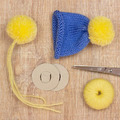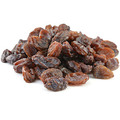Casting on is the first step in learning to knit. There are several methods. In our video, expert knitter Rachel Ong uses the thumb method.
Make a slip knot
You will need to make a slip knot to attach the knitting yarn to your knitting needle.
Do this by unwinding a strand of yarn at least 8 inches long from the ball and hold it in your left hand between your thumb and forefinger.
With your right hand, wrap the ball end of the yarn clockwise around your forefinger and middle finger, with your fingers spread approximately 1 inch apart.
Pull a loop of the ball end of the yarn through the loop of yarn around your fingers.
Drop the yarn off the fingers of your left hand while still holding on to the loop with your right hand and gently pull the tail end until a knot forms at the bottom of the base of the loop.
You have now created a slip knot.
Position the slip knot
Slide the slip knot onto your knitting needle, and pull the long tail and ball ends to tighten it around the needle.
The slip knot should be able to slide on the needle, not so tight it can't move and not too loose it can slide off.
You are now ready to cast on
Casting on
Putting the first row of yarn loops on your knitting needle is called casting on and the easiest way of doing this is using your thumb and index finger.
Hold the needle with the slip knot in your right hand and hold the ball end of the yarn with the bottom three fingers of your left hand. Allow the yarn to cross over your palm and clockwise over your thumb.
With your knitting needle, scoop up the yarn at the base of your thumb. Move the needle in a clockwise direction and scoop up the yarn that runs from between the needle and your index finger.
Drop the loop that is on your thumb onto the knitting needle, drop the yarn in your left hand and pull the thread tight.
Repeat this process until you have cast on the number of stitches that you need. The more stitches you cast on, the wider your piece of knitting will be.
Once your first row of cast-on stitches is on the needle, you are ready to move on to the knit stitch.
Thanks for watching
Need more help? See our step-by-step learn to knit guide, in pictures.
You might also like...
See more learning-to-knit videos here
Learn a new craft: see all of our beginners' guides










